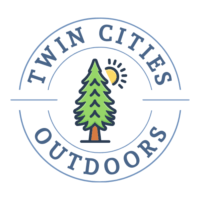This is the story of a Twin Cities woman’s 3-day solo backpacking trip on a section of the Superior Hiking Trail. She wanted to tell her own story, and I let her because she’s my sister 🙂
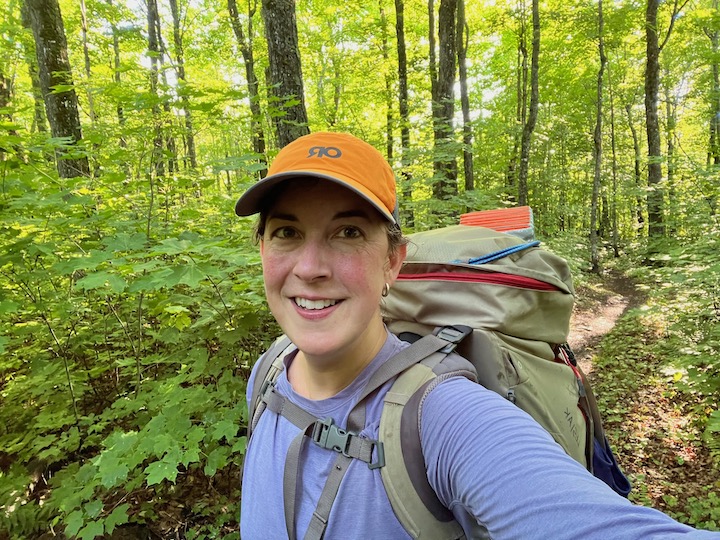
Maybe this is something you’ve always wanted to do, too. We hope this will encourage you to go for it…
By Katy Lesiak
I love nature, and I love hiking. But even for me, the idea of camping alone in a remote area for days at a time was a long time coming. I had to get experienced enough, and desperate enough, for some time alone on the trail.
I also love people, but none of my people were able to join me, and (as I alluded to) I was getting desperate. I really needed to get away, and needed some peace and quiet. Maybe some time for reflection, inspiration or insight. Or a new perspective on life.
Like many others in mid-life, I’m alarmed at my fading muscles and growing “survival pack” (my expanding belly and backside these days). I want to feel strong, alive and ready for many more healthy years.
So I need to move my body. And I guess I want to prove to myself I’m still that person who can do that kind of thing.
As a worrier by nature, my biggest fears when it comes to camping is getting squashed under a tree in my tent and Lyme disease. But I found myself ready to face a night or two alone on the trail, and alone in my tent in the middle of nowhere.
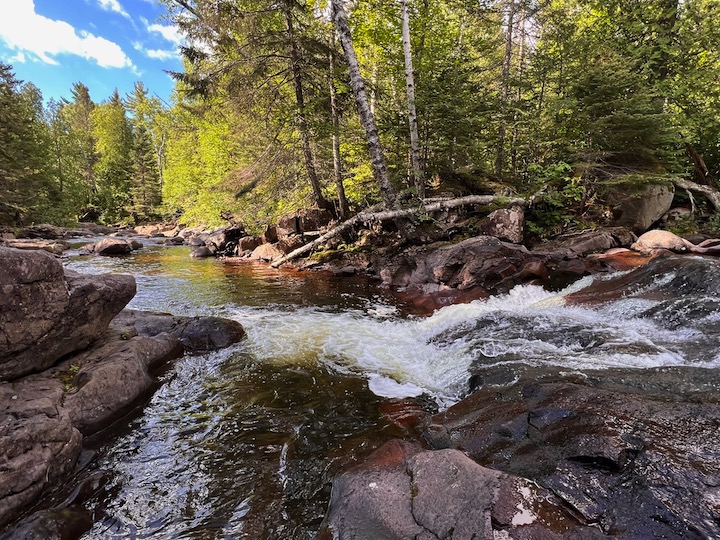
It never occurred to me to hike on my own until this past year. I have loads of local friends and family who love the outdoors, but it’s surprisingly difficult to align schedules, desires and abilities to plan a trip together.
A male friend of mine inspired me with his many solo hikes. I often found myself saying, “I wish I could do that.” Eventually, I decided there wasn’t really a good reason I couldn’t.
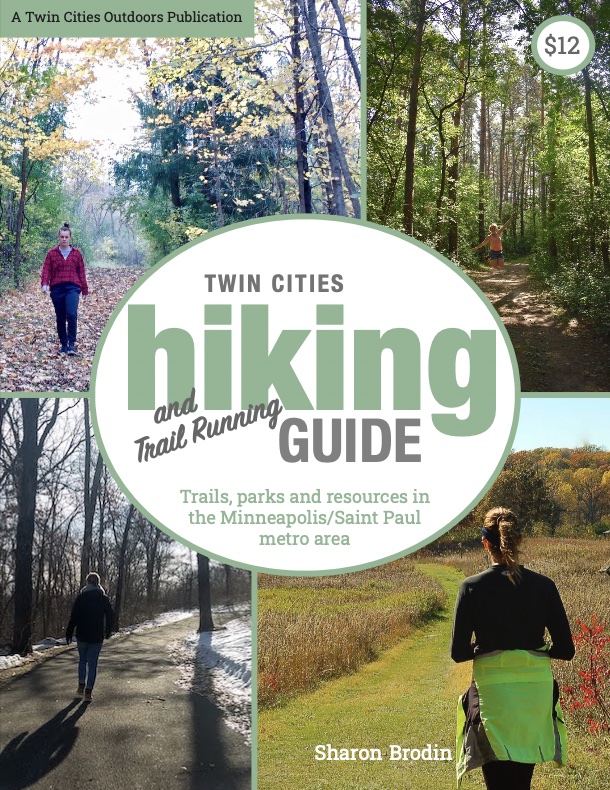
Twin Cities Hiking & Trail Running Guide
Published in 2020 and updated in 2023, our 48-page digital Hiking & Trail Running Guide is the easiest way to find hiking and running trails in all seven counties of the Twin Cities metro area.
So last October I dipped my toe in by hiking four miles into the Boundary Waters, with all my supplies on my back, to meet my husband and nephew for their annual whitefish netting canoe trip.
I met not a soul on the trail, including beasts of prey and ax-murderers. I easily followed the trail with my AllTrails app (even with almost zero cell coverage), and was rewarded with a couple of overlooks with the last hints of gold in the trees over the lakes.
The four miles took me about two hours, including snack and photo breaks. The hike back, after a couple of days of camping and paddling with the guys, was easier. I was stronger and my load was lighter. I had also become a GoGirl super user (more on that later).
Fast forward to this August, a couple weeks short of having to return to work as a school nurse (love it, though I do).
I was desperate to fit in a “real” vacation, without enough time for a road trip to Somewhere Interesting or a canoe trip in the BWCA.
And, having no one else around equally desperate to do any of those things, I made the decision that a short, wildernessy solo backpacking trip could and should be done. Two days later, I was on my way.
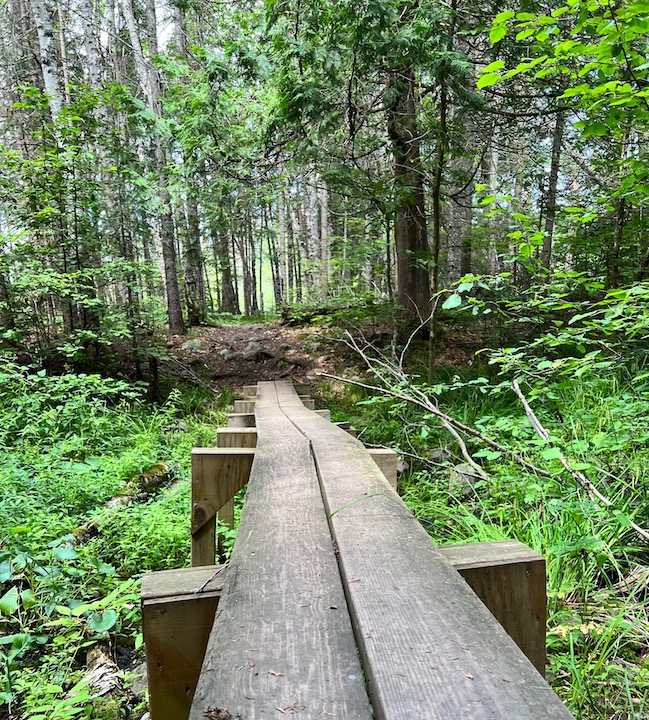
Here’s a summary of my solo camping hurdles and how I handled them:
Knowing Where to Go on the Superior Hiking Trail
I knew from friends and a Facebook group that the Superior Hiking Trail is beautiful, moderately challenging, worthwhile and long.
It also happens to be conveniently located along the route my family would be traveling in a few days to head to Grand Marais—perfect for a meet-up afterwards.
To learn more, I used these resources:
Superior Hiking Trail Website
The Superior Hiking Trail Association (SHT) website has a wealth of information, including a description of the trail sections, overnight parking options and current conditions.
Unlike the Boundary Waters or campgrounds, no reservations or permits are needed for SHT camp sites. They’re free, and they hold more than one tent pad—so you go in with the understanding that you may be sharing a campsite.
All Trails App
Once I understood the overall layout of the SHT from the website, I moved to my personal favorite trails app, All Trails.
I found a map of Section 4 of the trail and could zoom in and out to find campsites and likely water sources.
I determined a length of hike that was doable for me in the two nights and three days I had available to me. I figured I could probably do 8-10 miles max per day, at an average of a couple miles per hour.
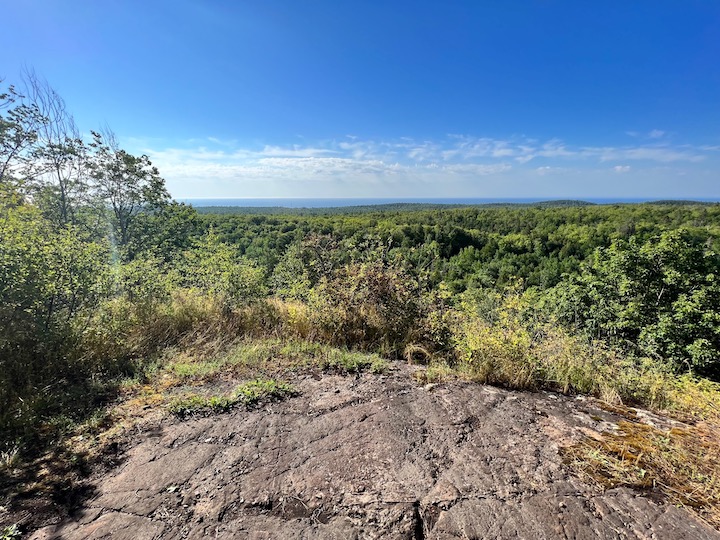
Superior Hiking Trail Facebook Group
The public Superior Hiking Trail Facebook group offers both inspiration and first-hand, current crowd-sourced info about the trail and logistics for anyone from beginner to expert.
Once I narrowed down the section of trail I wanted to do—I found promising area along the Cross River—I posted questions asking what it’s like and whether I was likely to get a campsite overnight.
I soon had plenty of recent travelers assure me this was a beautiful spot with ample camping space.
Superior Hiking Trail Guidebook
I read an older SHT guide book to learn more about the land I’d cover—important milestones, water access, things to watch for to keep it interesting and where I’d want to spend more time.
I realized that, while the landscape hasn’t changed much in 20 years, whether or not a creek has run dry is less sure. This is where I’d bring specific questions to the Facebook group or to the SHT website to learn the latest.
A Paper Map
The AllTrails app map worked consistently well, even when I didn’t have a cell signal or went on airplane mode to save battery.
It’s still wise to have a paper map along, though, in case of technical difficulties.
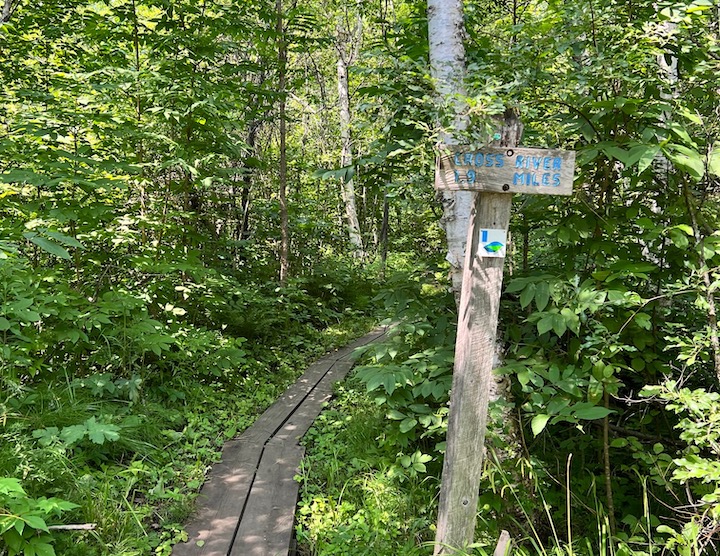
The Right Gear: Beg, Borrow, or (if you must) Buy
I read Cheryl Stayed’s book, Wild. One of my favorite parts is her process of mile-by-mile chucking the extra weight in her pack, as it came to feel less and less necessary.
I already had a small pack, and was pleased to see that after I whittled down all my items to put in it, I could still lift it and walk out the door.
Consumables (Food and Water)
Water: Water is essential…and heavy. I brought one Nalgene and filled it with water before I left. I borrowed my nephew’s 1-liter water filtration bag that’s the size of your average water bottle. Every water source I passed, I refilled it and could drink straight from it, or squeeze the water into my little cooking mug.
Food: For a long time our family has learned to prepare dehydrated, ready-to-make, just-add-boiling water meals for our outback trips. But I didn’t have time for a lot of food prep for this trip. So I bought two single-serving dehydrated meals from REI. They were absolutely delicious, if you don’t mind paying $8.95 per serving. In this case, it turned out to be well worth it.
Stove: I borrowed my nephew’s nifty little one-person stove/cook kit. It’s the tiniest, lightest easiest little thing you ever did see. You set the titanium mug on top as a pot, to boil enough water for your personal meal, plus a cup of instant coffee. The little stove and propane canister fit into the mug with its cover.
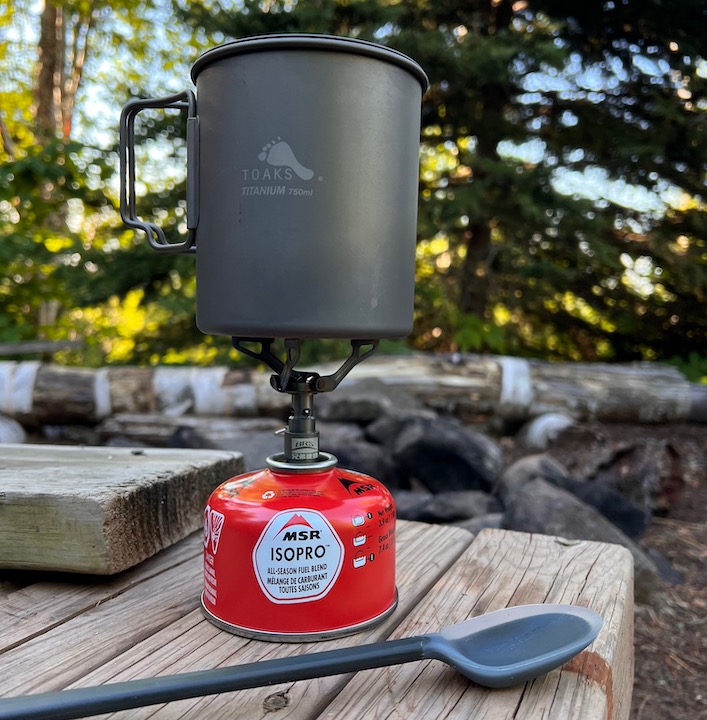
Wearables
Hiking boots and socks: Hiking shoes or boots that work well are essential—especially if you’re like me and have arthritis, a propensity for blisters or aren’t used to walking 8-12 miles a day. I need boots on these rocky and rooty trails, not shoes. I like merino wool hiking socks because they wick, breathe and cushion well.
Clothing: I found that wearing light wicking pants and a long-sleeved shirt was just right, even though it was warm out. I would sweat no matter what, but with long pants and sleeves I didn’t feel the underbrush, creepy crawlies, spider webs or mosquitos on my skin.
I was glad I soak-sprayed my clothes and a light baseball cap with permethrin before I left for my trip, to keep the bugs away.
Sleepables
Sleeping: I couldn’t find my sleeping bag’s compression stuff sack, so I packed it in a dry bag. It was harder to compress, but worked great as my bear bag overnight. It took up more space than necessary in my pack, so I kicked out my hammock—which I missed.
I brought a dimpled foam sleeping pad that easily strapped to the outside of my pack. I used my clothes sack as a pillow, since I couldn’t find our teeny-tiny camp pillow. Not the best.
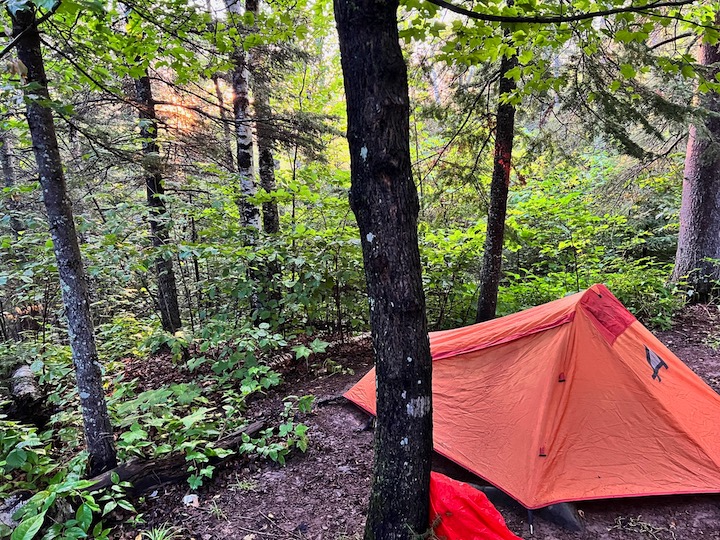
(PRO TIP: Keep all your outdoor gear in one spot in case you plan a last-minute trip like this.)
I borrowed my nephew’s one-person tent, which kept me dry on a very rainy night (I obviously owe a debt of gratitude to my nephew!)
Everybody Poops
This tops the list of things I hate to do in the wilderness: squatting for either #1 or #2, and trying to clean up well afterwards.
Two fantastic things: the SHT has thrones, so you can sit to poo. And GoGirl makes it possible for women to stand to pee. If you use it properly, you can make it through with neither dribble nor splatter.
I have a near paranoia of running out of toilet paper. I always end up, despite all efforts, with a mere 1.5 squares of toilet paper left at least 24 hours before my trip is over. Next trip, I’m going to try some of those biodegradable wet wipes.
A real highlight—no kidding!—of this trip was the view from the loo at the Crystal Creek campsite. A glorious vista over ferns, birch and pines to the great Lake Superior far below. Can’t beat that for the morning business!
In case of emergency
First aid: I was very happy I brought the big Band-Aids and cloth First Aid tape when I developed blisters on my heel and toe by the end of Day 2. The ibuprofen came in handy as well. Tweezers and little scissors or a knife come in handy no matter where you are, home or away.
Communication: I left the weather radio at home. Being gone for 3 days, with some cell access, I knew what I needed to know ahead of time: it would rain, but no tree-toppling wind gusts predicted.
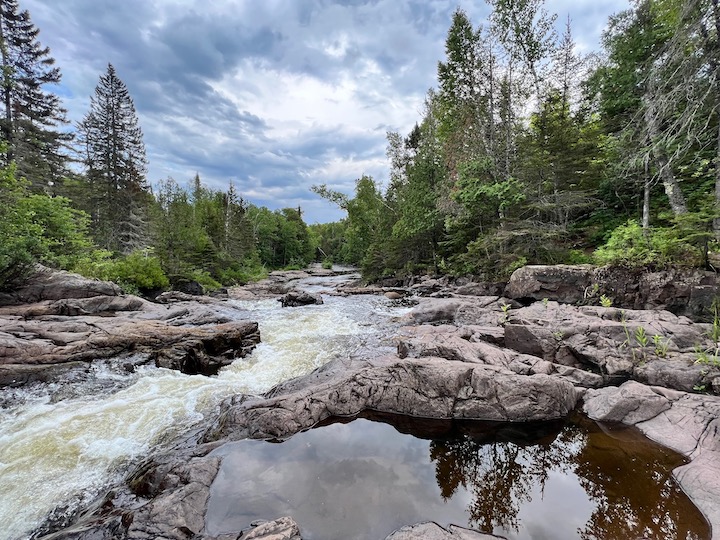
Getting Through My Fears
Weather
My great fear of falling trees stems from home life, where our 100-year-old cottonwood once dropped a tree-sized branch on our yard. This also stems from the occasional horror story of someone dying in the BWCA after straight-line winds.
I toyed with the idea of shortening my trip due to predicted rain, but decided that while rain can be uncomfortable and annoying, it’s not deadly. Winds were predicted to be decidedly non-life-threatening.
I was glad I hiked in on schedule! I enjoyed a full afternoon of beautiful hiking, set up the tent, took a dip in the refreshing Cross River, and cooked my dinner before any hint of moisture or thunder was in the air.
Later, the rain was heavy with some thunder and lightening, but I slept, and woke up in the morning in a dry tent.
Beasts and bugs
No, I didn’t see any bears. Or moose or deer or wolves. I faithfully roped up my food in a raised bear bag the first night on the trail, as I’ve learned on every outing since junior high adventure camp.
At my second campsite, there were no trees with horizontal branches to raise a bag high above the ground. However, it soon be came obvious the clear and present danger wasn’t a bear, but a very assertive chipmunk.

So I strung my rope between two birch trees, 4-5 feet above the ground, and that kept my food safe all night.
My only creature-related freakout moment was when I nearly face-planted with a slug suspended by its web from an overhanging branch!
That was the one and only time I shrieked during my solo trip. I was increasingly disconcerted when I narrowly avoided colliding with a 2nd and then a 3rd dangling slug. But it led to no great harm.
The bugs were there. I was protected head and neck to foot, but my face and ears were fair game. Even though a lot of greenery brushed up against my legs and torso, I found no other creepy crawlies, including ticks.
But Why Do This?
For anyone who really enjoys the outdoors, the Boundary Waters, a local hike, or the small wonders seen on a new trail, I don’t have to explain the “why” to you. For some reason we do it all in spite of the fears, sweat, blisters and prep work.
Did this end up being the spiritual, perspective-shifting experience I hoped, as a first-time solo hiker?
No. I tried journaling but didn’t have much to say. I was too tired to sit (especially without a hammock or camp chair) and meditate quietly on my life. When I laid down in my tent before it was even dark, I fell asleep with my book on my chest, literary insights lost on my tired bones.
While I walked and swatted mosquitos, felt the sweat dripping, shifted my pack to a more comfortable position, I thought. Or I didn’t think.
When I had the opportunity, I dipped in the cold water in the Cross and Caribou rivers. I gazed with heart eyes (per the emoji) at a resident campsite frog.
Sometimes I was surprised by a thimbleberry, raspberry or a couple of blueberries—delicious! Just what I needed. I saw a deep purple bog orchid. I crossed rickety planks that challenged my pack-dominated balance.
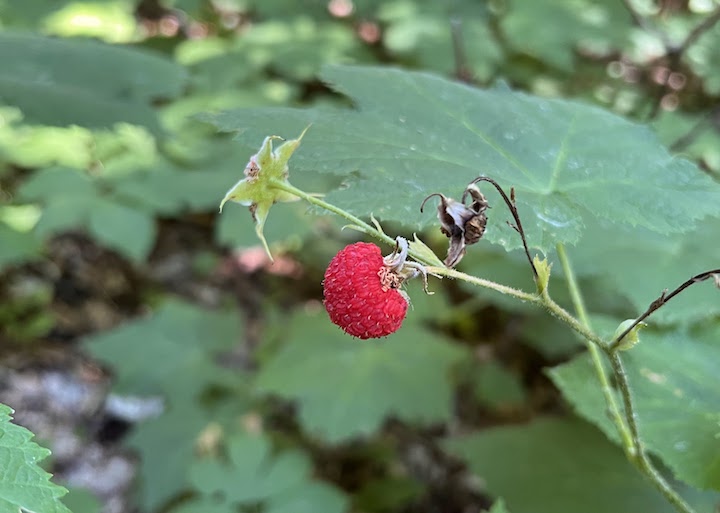
I thought about all the stomach bugs I could get from the creek water, then decided (again) to trust my water filter. I savored the flavors of my hard-earned dehydrated meals.
Once, in the middle of the storm on that first night, I had a fleeting image of myself as a little speck in the middle of a vast forest, far away from anyone else, all alone.
And then I pushed the thought away and felt my weight on the sleeping bag, my head on my sweatshirt, heard the sound of fat rain drops on the tent canopy, and fell asleep.
Back to “Real” Life
I know from experience the hardest thing can be the first few hours and days coming out of a wilderness trip.
On the trail I eat well and my body thanks me for it. I move a lot and feel stronger physically and clearer mentally. I emerge with a different perspective.
When I go back home, the snacks, couch, screens and life messes are there waiting for me. In the past I’ve been frustrated by the rebound effect—more sugar, less movement, messy thinking.
It was helpful to remember this before I left the trail, and to prepare myself.
I like how my body and soul feel when I reconnect with nature and pull away from these everyday things, even for a short time. Maybe as I get to be 50 and 60 and 70 years old, I can keep doing this, and practice wiring those memories into everyday life.
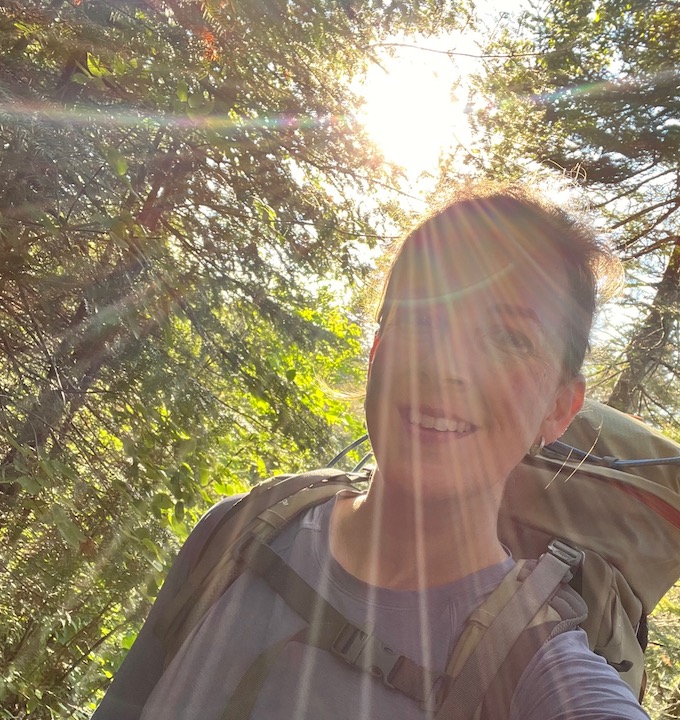
After I returned from my relatively remote, solo experience, I sent a message to my mother and family letting them know I had done this undoable thing, and that I was alive and well.
My mom appreciated being able to skip to that part of the story where you know it all turns out well in the end. I haven’t told her yet, but I think this may not be the end…
Here’s an overview of my journey on All Trails.
(All photos courtesy of Katy Lesiak)

Twin Cities Hiking & Trail Running Guide
Published in 2020 and updated in 2023, our 48-page digital Hiking & Trail Running Guide is the easiest way to find hiking and running trails in all seven counties of the Twin Cities metro area.
You’ll like these, too…
- Outdoors Beyond the Twin Cities
- Best Hikes in the Twin Cities for a Great Workout
- Outdoor Clubs and Groups in the Twin Cities
- New Winter Gear: How Do These Perform? - November 29, 2023
- Paddle North: SUPs, Kayaks and More - November 20, 2023
- 2023 Holiday Gift Guide for Outdoor Lovers - November 10, 2023
